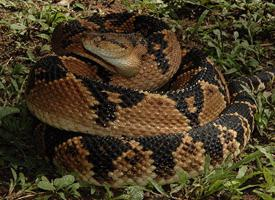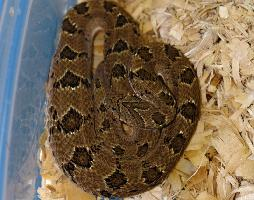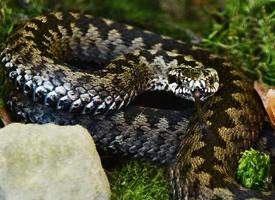
Poids et mesures
| Longueur | de 210 à 360 cm |
|---|
Description de l'animal
The Southern American bushmaster, scientifically known as Lachesis muta, is a fascinating and formidable species of venomous snake, belonging to the Viperidae family. This species holds the title of the longest pit viper in the world, with some specimens reaching lengths of up to 12 feet (3.65 meters), although the average size is typically around 6 to 9 feet (1.8 to 2.7 meters). Its robust body, marked by a distinctive color pattern of reddish-brown and yellowish bands, makes it an imposing figure within its natural habitat.Native to the tropical rainforests of South America, the Southern American bushmaster is found in countries such as Brazil, Colombia, Ecuador, Peru, Venezuela, and parts of the Guianas. Its preference for humid and dense forest environments, often near streams or wet areas, provides it with ample cover and hunting grounds. The snake is primarily nocturnal, spending its days hidden in the leaf litter or burrows, emerging at night to hunt.
The diet of Lachesis muta primarily consists of small mammals, including rodents, which it ambushes using its potent hemotoxic venom. This venom is not only capable of causing significant tissue damage but also disrupts the victim's blood coagulation processes, leading to a swift and fatal outcome. Despite its fearsome reputation, the Southern American bushmaster is an elusive creature, avoiding human contact whenever possible.
One of the most remarkable features of the Southern American bushmaster is its heat-sensing pits located between the eyes and nostrils on either side of its head. These pits allow the snake to detect minute variations in temperature, enabling it to accurately locate warm-blooded prey even in complete darkness. This adaptation, combined with its stealth and camouflage, makes it an apex predator within its environment.
Reproduction in Lachesis muta is oviparous, meaning the snake lays eggs rather than giving birth to live young. Females lay clutches of 10 to 20 eggs, which they incubate for approximately six months. During this period, the female bushmaster exhibits a rare behavior among snakes: she guards her nest vigorously against potential predators, a testament to the species' strong maternal instincts.
Despite its impressive size and capabilities, the Southern American bushmaster faces threats from habitat destruction and human encroachment. Deforestation and land development in South America have led to a decrease in suitable habitat for this species, impacting its population numbers. Furthermore, the snake is often killed on sight due to fear and misunderstanding of its nature.
In conclusion, the Southern American bushmaster (Lachesis muta) is a remarkable species, embodying the power and mystery of the natural world. Its adaptation to the dense forests of South America, combined with its unique biological traits, make it a fascinating subject of study for herpetologists and wildlife enthusiasts alike. However, like many of the world's most intriguing creatures, it faces challenges that threaten its survival, reminding us of the importance of conservation efforts to preserve the biodiversity of our planet.
Animaux similaires
Nouvelles photos d'animaux
Top 10 des animaux
- Dolphin gull (Leucophaeus scoresbii)
- Diana monkey (Cercopithecus diana)
- Moustached guenon (Cercopithecus cephus)
- Galápagos tortoise (Geochelone nigra complex)
- Stone loach (Barbatula barbatula)
- Japanese macaque (Macaca fuscata)
- Russian tortoise (Testudo horsfieldii)
- Greek tortoise (Testudo graeca)
- Common flying dragon (Draco volans)
- Vendace (Coregonus albula)


